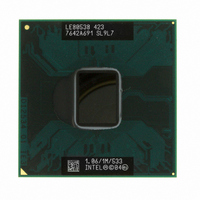LE80538VE0041M Intel, LE80538VE0041M Datasheet - Page 13

LE80538VE0041M
Manufacturer Part Number
LE80538VE0041M
Description
IC PROC CELERON M 1.06GHZ 479BGA
Manufacturer
Intel
Datasheet
1.LE80535NC013512.pdf
(69 pages)
Specifications of LE80538VE0041M
Processor Type
Celeron M
Features
533MHZ Bus, 1M L2 Cache
Speed
1.06GHz
Voltage
0.94V
Mounting Type
Surface Mount
Package / Case
479-BGA
Lead Free Status / RoHS Status
Lead free / RoHS Compliant
Other names
883549
Available stocks
Company
Part Number
Manufacturer
Quantity
Price
2.1.6
2.2
Intel
®
Celeron
®
M Processor Datasheet
the assertion of the SLP# signal. The SLP# pin should only be asserted when the processor is in the
Stop Grant state. SLP# assertions while the processor is not in the Stop-Grant state is out of
specification and may result in unapproved operation.
Snoop events that occur while in Sleep State or during a transition into or out of Sleep state will
cause unpredictable behavior.
In the Sleep state, the processor is incapable of responding to snoop transactions or latching
interrupt signals. No transitions or assertions of signals (with the exception of SLP#, DPSLP# or
RESET#) are allowed on the FSB while the processor is in Sleep state. Any transition on an input
signal before the processor has returned to Stop-Grant state will result in unpredictable behavior.
If RESET# is driven active while the processor is in the Sleep state, and held active as specified in
the RESET# pin specification, then the processor will reset itself, ignoring the transition through
Stop-Grant State. If RESET# is driven active while the processor is in the Sleep State, the SLP#
and STPCLK# signals should be deasserted immediately after RESET# is asserted to ensure the
processor correctly executes the Reset sequence.
While in the Sleep state, the processor is capable of entering an even lower power state, the Deep
Sleep state by asserting the DPSLP# pin. (see
state, the SLP# pin must be deasserted if another asynchronous FSB event needs to occur.
Deep Sleep State
Deep Sleep state is a very low-power state the processor can enter while maintaining context. Deep
Sleep state is entered by asserting the DPSLP# pin while in the Sleep state. BCLK may be stopped
during the Deep Sleep state for additional platform-level power savings. BCLK stop/restart timings
on Intel 855PM/ICH4-M, Intel 855GM/ICH4-M, and Intel 852GM/ICH4-M chipset-based
platforms with the CK-408 clock chip are as follows:
To re-enter the Sleep state, the DPSLP# pin must be deasserted. BCLK can be restarted after
DPSLP# deassertion as described above. A period of 30 microseconds (to allow for PLL
stabilization) must occur before the processor can be considered to be in the Sleep State. Once in
the Sleep state, the SLP# pin must be deasserted to re-enter the Stop-Grant state.
While in Deep Sleep state, the processor is incapable of responding to snoop transactions or
latching interrupt signals. No transitions of signals are allowed on the FSB while the processor is in
Deep Sleep state. Any transition on an input signal before the processor has returned to Stop-Grant
state will result in unpredictable behavior.
When the processor is in Deep Sleep state, it will not respond to interrupts or snoop transactions.
FSB Low Power Enhancements
The Intel Celeron M processor incorporates the following FSB low power enhancements:
•
•
•
Deep Sleep entry - DPSLP# and CPU_STP# are asserted simultaneously. CK-408 will stop/
tristate BCLK within 2 BCLKs +/- a few nanoseconds.
Deep Sleep exit - DPSLP# and CPU_STP# are deasserted simultaneously. CK-408 will drive
BCLK to differential DC levels within 2-3 ns and starts toggling BCLK 2-6 BCLK periods
later.
Dynamic FSB power-down
Section
2.1.6.). While the processor is in the Sleep
Low Power Features
13












